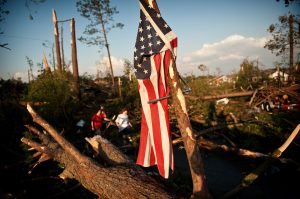Severe Weather
While precipitation totals on a monthly, seasonal, or annual scale are not necessarily increasing, we are seeing that the pattern of precipitation is changing.
When we think of severe weather, thunderstorms and tornadoes typically come to mind. While the linkage between severe weather and climate change remains unclear, recent research has examined how the two key ingredients needed to produce severe thunderstorms, convective instability (warm, moist air at the surface and cooler, drier air aloft) and wind shear (vertical change in wind speed and direction required for tornado formation), might change in the future. Results suggest that a warmer atmosphere may boost the potential for stronger and more frequent thunderstorms by increasing instability, but vertical wind shear is likely to decrease, which reduces the likelihood for tornadoes.
Another important hazard associated with severe thunderstorms is the potential for heavy precipitation. Over the last few decades, much of the United States has witnessed an increase in heavy rainfall events. While precipitation totals on a monthly, seasonal, or annual scale are not necessarily increasing, we are seeing that the pattern of precipitation is changing. In essence, more precipitation is falling during the heaviest events and is thus comprising a greater proportion of total precipitation amounts recorded over a given month, season, or year. In fact, a 27% increase in heavy rainfall events has been observed across the Carolinas over the last 50 years. These heavy rainfall events often lead to flash flooding, which can be particularly dangerous for motorists in urban areas.
Climate Extremes
Select a climate extreme to access tools and learn more about community vulnerability and health impacts.




